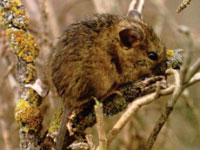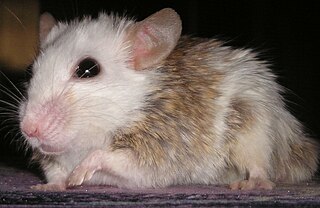
Chinchillas are either of two species of crepuscular rodents of the parvorder Caviomorpha, and are native to the Andes mountains in South America. They live in colonies called "herds" at high elevations up to 4,270 m (14,000 ft). Historically, chinchillas lived in an area that included parts of Bolivia, Peru and Chile, but today, colonies in the wild are known only in Chile. Along with their relatives, viscachas, they make up the family Chinchillidae. They are also related to the chinchilla rat.

The family Chinchillidae is in the order Rodentia and consists of the chinchillas, the viscachas, and their fossil relatives. This family is restricted to southern and western South America, mostly living in mountainous regions of the Andes but one species living on plains. They are medium to large-sized rodents, weighing from 800 g (28 oz) to 8 kg (18 lb), with strong hind legs and large ears and a bushy tail. All species have thick, soft fur, which is considered valuable in some cultures.

The rodent subfamily Sigmodontinae includes New World rats and mice, with at least 376 species. Many authorities include the Neotominae and Tylomyinae as part of a larger definition of Sigmodontinae. When those genera are included, the species count numbers at least 508. Their distribution includes much of the New World, but the genera are predominantly South American, such as brucies. They invaded South America from Central America as part of the Great American Interchange near the end of the Miocene, about 5 million years ago. Sigmodontines proceeded to diversify explosively in the formerly isolated continent. They inhabit many of the same ecological niches that the Murinae occupy in the Old World.

Apodemus is a genus of Muridae. The name is unrelated to that of the Mus genus, instead being derived from the Greek ἀπό-δημος.

Chinchilla rats or chinchillones are members of the family Abrocomidae. This family has few members compared to most rodent families, with only nine known living species. They resemble chinchillas in appearance, with a similar soft fur and silvery-grey color, but have a body structure more like a short-tailed rat. They are social, tunnel-dwelling animals, and live in the Andes Mountains of South America. They are probably herbivorous, although this is not clear.

The gray leaf-eared mouse is a rodent species from South America. It is found in Argentina, Bolivia, Brazil and Paraguay; its habitat includes the Gran Chaco.

Reithrodontomys is the genus of groove-toothed New World harvest mice.

The long-tailed chinchilla, also called the Chilean, coastal, common, or lesser chinchilla, is one of two species of rodent from the genus Chinchilla: the other species being C. chinchilla. Both species are endangered in the wild after historically being hunted for their soft hair coats. Domestic breeds of chinchilla are believed to descend from specimens of C. lanigera. Domestic chinchillas come in three types: la plata, costina, and raton.

The Altiplano chinchilla mouse or achallo is a species of rodent in the family Cricetidae. It is the only species in the genus Chinchillula. It is found in Argentina, Bolivia, Chile, and Peru.

The Patagonian chinchilla mouse is a species of rodent in the family Cricetidae. It was first described by George Robert Waterhouse in 1839. It is found in Tierra del Fuego and neighboring areas of southernmost Argentina and Chile.
The biting chinchilla mouse is a species of rodent in the family Cricetidae. It is found in west central Argentina and nearby areas of Chile, where it inhabits highland meadows, probably at elevations of 1740 to 3000 m.
Peterson's chinchilla mouse is a species of rodent in the family Cricetidae and is found in west central and southern Argentina and nearby areas of Chile. The species is named after American paleontologist Olaf A. Peterson (1865–1933).
Habromys is a genus of rodent in the family Cricetidae, found in Mexico and Central America. It contains these species, all but one of which are threatened or endangered, five of them critically so. H. lophurus is near threatened.

Mastomys is a genus of rodent in the family Muridae endemic to Africa. It contains eight species:

Steatomys is a genus of rodent in the family Nesomyidae. It contains the following species:
Frenkelia is a genus of parasites in the phylum Apicomplexa. The species in this genus infect the gastrointestinal tracts of birds of prey and the tissues of small rodents.
The burrowing chinchilla mouse is a species of rodent in the family Cricetidae. It is found in Salta Province, Argentina.











